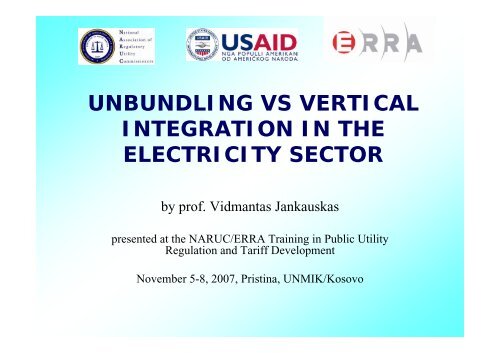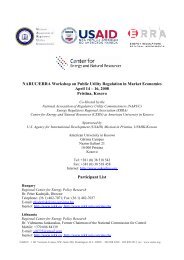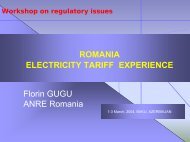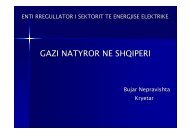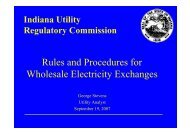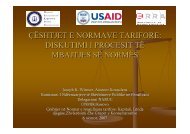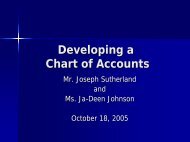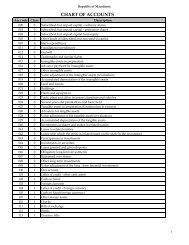Unbundling and Vertical Integration - Narucpartnerships.org
Unbundling and Vertical Integration - Narucpartnerships.org
Unbundling and Vertical Integration - Narucpartnerships.org
Create successful ePaper yourself
Turn your PDF publications into a flip-book with our unique Google optimized e-Paper software.
UNBUNDLING VS VERTICALINTEGRATION IN THEELECTRICITY SECTORby prof. Vidmantas Jankauskaspresented at the NARUC/ERRA Training in Public UtilityRegulation <strong>and</strong> Tariff DevelopmentNovember 5-8, 2007, Pristina, UNMIK/Kosovo
Overview• Unbundle: why <strong>and</strong> how?• Cross-subsidies <strong>and</strong> ways to avoid them• EU third package• Eurelectric’s proposal2
Why <strong>and</strong> how?
The power industry: from plant towall socketGenerationTransmissionDistributionSupply(billing, customer services)4
<strong>Vertical</strong>ly integrated utilitymodel• Central dispatch of generation• IPPs cannot enter the market• Costs are recovered at utility level <strong>and</strong> revenue isdistributed• Centrally planned investments• Risk of investments are passed through toconsumers• Regulator is the Ministry• Public ownership5
Why to change it?• Political will (liberal economy ideology) in GreatBritain (M. Thatcher), Australia, Chile, Norway,EU, etc.• Global competition challenge for manufacturingindustries• Significant price differences in Europe• New technologies (CCGT)6
Why to unbundle?• The main idea that underlines the new world ofcompetition <strong>and</strong> choice in electricity is that it ispossible <strong>and</strong> desirable to separate thetransportation from the goods transported• Electric energy as a product can be separatedcommercially from transmission/distribution as aservice• Electricity bill to be split into an electricity(commodity) <strong>and</strong> system (transportation) charges7
8Legal requirements onunbundling– timeline2 nd Liberalisation Directive:Directive 2003/54/EC legal <strong>and</strong>functional unbundling for TSOs <strong>and</strong>DSOs (> 100.000 connected customers)3 rd Liberalisation Directive: Proposalslaunched on 19 th September –ownership unbundlingFull implementation of3 rd Liberalisation Package?1 st Liberalisation Directive:Directive 96/92/EC accountsunbundling for TSOs <strong>and</strong> DSOs1996 2003 2007 20??
Functional unbundling• Objective: To ensure the independence of theTSO or DSO functions within a verticallyintegrated utility *• Transmission <strong>and</strong> distribution must beindependent in terms of <strong>org</strong>anization <strong>and</strong> decisionmakingfrom other activities not related to thenetworks* ‘<strong>Vertical</strong>ly Integrated Utility’: A utility or a group of utilities performing atleast one of the functions of transmission or distribution <strong>and</strong> at least oneof the functions of generation/production or supply9
The following minimumcriteria apply:• Those responsible for the management of the TSO/ DSOmay not participate in company structures of theintegrated undertaking responsible directly or indirectlyfor the day to day operation of the other interests.• Appropriate measures must be taken to ensure that themanagement of the TSO/ DSO is capable of actingindependently.• The TSO/ DSO shall have effective decision-makingrights, independent from the VIU, with respect to assetsnecessary to operate, maintain or develop the network.• The TSO/ DSO shall establish a compliance programmewith measures to ensure that a discriminatory conduct isexcluded <strong>and</strong> to ensure its respect is adequatelymonitored.10
Legal unbundling• Objective: To make a distinction between theperformance of TSO <strong>and</strong> DSO functions asseparated from other activities not related totransmission <strong>and</strong> distribution• In principle, legal unbundling means thattransmission <strong>and</strong> distribution are to be done by aseparate “network” company11
Ownership unbundling• Objective: To separate the TSO <strong>and</strong> DSOfunctions from other activities not related totransmission or distribution by transferring theownership of the networks to a different entity• Transmission <strong>and</strong> distribution networks areoperated under different ownership thangeneration/production <strong>and</strong> supply12
Cross-subsidies <strong>and</strong> how toremove them13
Cross-subsidizationIn general, cross-subsidization has the shape oftransferring revenues earned from regulated services tounregulated services.The objective is to make the unregulated service morecompetitive...... as the costs may be recovered from the regulated services(whose prices are based on accounting instead ofcompetitiveness)14
Undesirable effects of crosssubsidies• After the introduction of competition, crosssubsidiesmay continue to exist– Some may be beneficial, e.g. when they are in line withsocial policies <strong>and</strong> abuse is limited.– However, some may be detrimental, e.g. when theseoriginate from a company’s strategy to benefit from itsmarket position.• Such is especially the case when competitive(unregulated) business is subsidized fromregulated activities.15
ThereforeCompetition functions <strong>and</strong> monopoly functionsshould be <strong>org</strong>anized in separate companies(corporate unbundling) in order to avoid crosssubsidization<strong>and</strong> distortion of competition16
Policy approaches (1)• The strongest possible approach would be to prohibitthe transmission utility from participating in generationbusiness <strong>and</strong> distribution utility from participating inthe unregulated retail market– This would remove the opportunity to engage in the kind ofcross-subsidization <strong>and</strong> discrimination discussed above.– But this prohibition also would prevent the realization of anyeconomies of scope that otherwise might exist.17
Policy approaches (2)• Another possible, but softer approach would be toallow transmission companies to take part ingeneration business <strong>and</strong> distribution companies toparticipate in the retail electricity market, but onlythrough requiring separate operations of the utility<strong>and</strong> its unregulated affiliate(s)• Such separation can entail requirements that theutility not share employees or assets with itsaffiliate, <strong>and</strong> may even require financial <strong>and</strong>management separation18
Comparison of differentunbundling methodsType ofseparationDescriptionPossiblecrosssubsidiesHow to avoidAccountingSeparate accountsYesVery strongregulatoryoversightFunctional/managementDifferent divisionswith differentmanagementYes-”-LegalLegally separate bodiesowned by the samecompanyYesStrong regulatoryoversightOwnershipSeparate ownership ofcompanieseliminatedavoided19
Problems of improperunbundling• TSO/DSO bundled with generation– Incentive to restrict available transmission capacity forindependent players at borders to prevent from importcompetition– Incentive to cross-finance generation• TSO/DSO bundled with trader– Incentive to provide a trader with superior informationabout customer related data– Incentive to cross-finance predatory practices of atrader20
EU third package21
<strong>Unbundling</strong> proposals publishedby the European Commission• 3 rd liberalisation package– Launched 19 September 2007• For TSOs– Ownership unbundling OR– Independent System Operator (“Deep ISO+”)• For DSOs– Existing unbundling framework remains almostunchanged22
Why ownership unbundling?• TSO may treat its affiliated companies better thancompeting third parties• Integrated companies may use network assets tomake entry more difficult for competitors• Non-discriminatory access to information cannotbe guaranteed as there are no effective measuresof preventing TSO releasing market sensitiveinformation to its generation <strong>and</strong> supply affiliates• Investment incentives within an integratedcompany are distorted23
Pros <strong>and</strong> consof TSO ownership unbundling• Pros– Clear cut solution– Full independence of network <strong>and</strong> competitive business• Cons– Does not necessary solve the current regional marketproblems, i.e. further market integration, more investments– Would take too long, long legal battles might follow– alternative proposal – ISO has its weaknesses also24
Transmission vs. distribution• Common goal of unbundling:– Non-discriminatory access to networks– No cross-subsidisation between regulated <strong>and</strong> non-regulatedbusinessBUT• Different treatment re. ownership unbundling because– Ownership unbundling for DSOs is much too far reachingfinancially. Difficult to find competent investors– DSOs provide lesser risk of discriminatory behaviour– Investment decisions are made purely to serve the customer<strong>and</strong> not driven by political interests25
Eurelectric’s proposal26
Overview of TSOs in the EUEU requirements on TSO unbundlingfully implemented in all Member StatesApproximately half of the TSOs areownership unbundled, other half havelegal <strong>and</strong> functional unbundling27
Independent System Operators• EC proposes ISOs as alternative (second best) to theTSO ownership unbundling (“Deep ISO+”)– ISO in charge also for maintenance <strong>and</strong> network investment– Asset owner reduced to mere capital ownership• ISOs are currently already in place in the US withvaried success• There are some doubts if ISOs on national level willhelp to market integration <strong>and</strong> not delay the process28
Regional Independent Operator– Eurelectric’s proposal• Electricity industry discussion proposal: Go regional!• Establishment of Regional ISOs (= RIO) covering severalMember States/ control areas• <strong>Integration</strong> of TSO functions into a regional entity• RIO will guarantee fair <strong>and</strong> non-discriminatory access tothe networks, <strong>and</strong> at the same time is conducive to marketintegration• RIO would provide regional viewpoint also forinvestment planning29
Role of TSOs• Provide non-discriminatory <strong>and</strong> fair access to thetransmission network• Facilitate market development <strong>and</strong> marketintegrationSeamless cooperation of TSOs or integration of tasks in aregional entity (“Regional Independent Operator”)• Develop the transmission network from a regional<strong>and</strong> ultimately European viewpointInvestment decision to be taken for a “regional grid”• Provide security of energy supply30
Conclusions• Ownership unbundling is the best way to havecompetitive electricity market, avoid crosssubsidies<strong>and</strong> other distortions• But some large countries <strong>and</strong> many companies areagainst it, so independent system operator isproposed by the European Commission as thesecond best• Union of the electricity industry Eurelectricproposes the third option – regional independentsystem operator31
Thank you for your attention


